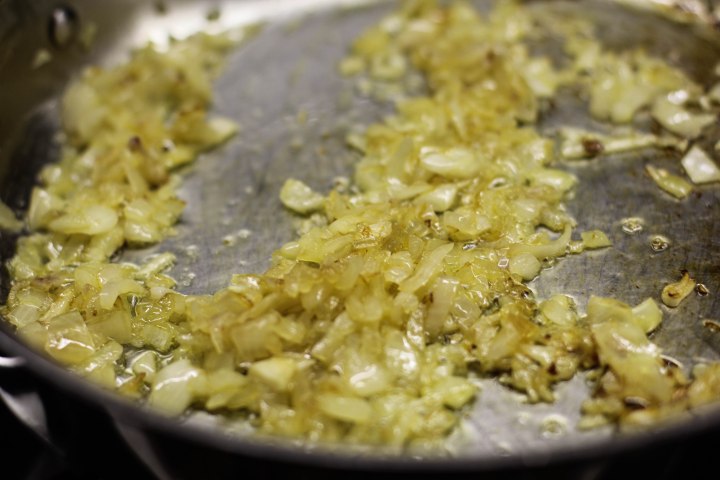
Food Science Friday Episode 2- All about Onions
Welcome back to another episode of Food Science Friday where we’re talking chemistry in the kitchen during quarantine!
Today we are discussing a topic that just makes me so emotional. In fact, I get so emotional over this vegetable that I’m having to wear my sunglasses indoors, because I couldn’t find my chem lab goggles.
That’s right! Today we’re talking onions.
Ever wondered why onions make you cry?
It’s not because onions make you emotional. Onions contain amino acid sulfoxides, which become sulfenic acid in the onion cells. When you cut an onion, you’re breaking the cells of the onion and allowing the lachrymatory factor synthase enzymes to mix with the sulfur containing compounds, which produces something called propanethiol S-oxide, a volatile gas, which is the lacrimatory factor.[1] The gas actually reacts with the tears in your eyes (already irritated) to form sulfuric acid, which burns and causes more tears![2]
Luckily, there’s a way to slow down the reaction, so let’s go back to basic biochem and talk enzyme kinetics.
You may remember that the rate of an enzyme-catalyzed reaction often increases as the temperature is raised. A ten degree Celsius rise in temperature will increase the activity of most enzymes by 50 to 100%. So, one way to slow down the chemical reaction is to keep the onions cool.[3]

often increase as temperature increases
So, pro-tip try storing your onions in the fridge before chopping. You might also try dunking them in boiling water to denature the proteins, but I’ve never tried that. Anyways, we’ve stored these onions in the fridge, so let’s get to work!
Perfect Caramelized Onions
Directions
- Slice your onions into strips.
- Place a large pan on the stove with 2 tbs. olive oil and heat on medium high.
- Once pan is warm, toss your onions in with 1 tsp. salt and distribute evenly.
- Cook on medium- high for about 10 minutes or until onions start to stick to the pan
- Turn down the heat to medium-low
- Add liquid and stir with a spatula, scraping some of the savory brown bits off the pan and keep the onions from burning
- Cook low and slow for approximately 45 minutes, stirring occasionally, until onions are soft, fragrant and a beautiful caramel color.
- Add to your favorite dishes!
So, let’s Break down what’s happening.
The term caramelizing onions is actually a bit misleading as there are multiple chemical reactions taking place side by side that lead to the gorgeous brown color and deep flavors that we attribute to the caramelization of onions. These non-enzymatic browning reactions include both caramelization and the Maillard reaction.
Caramelizing is the oxidation of sugar that results in a brown color and tasty nutty flavor. When you apply heat to onions, and the onions reach a certain temperature the complex sugar molecules of the starch (poly and disaccharides) that are present in onions are broken down into monosaccharides (single sugar molecules). If heating continues, these sugars will essentially melt and start to become smooth and glossy. Different sugars caramelize at different temperatures, and we know that fructose will caramelize at approximately 230 degrees F or 110 degrees C. This results in the darker color and sweeter taste.[4][5]

The Maillard reaction on the other hand, is a reaction between heated sugar and amino acids. It occurs in 5 steps: condensation, rearrangement, fragmentation, Strecker degradation, and polymerization. In the first step, sugar (the free carbonyl group on reducing sugars) reacts with certain amino acids (those with free amino groups) when heated. The amino acid involved actually partially determines the resulting flavor. The subsequent steps may vary.
The pH and moisture level can impact the Maillard reaction. Many people will add baking soda as an alkaline environment will stimulate the reaction by deprotonating the amino groups. I like to add salt to speed up the process, as[6] the salt will draw out some of the moisture, and increase the rate of the Maillard reaction[7].
I also add bit of wine or dry vermouth when the onions stick to the bottom of the pan as I find it adds flavor.
[1]Silvaroli JA, Pleshinger MJ, Banerjee S, Kiser PD, Golczak M. Enzyme That Makes You Cry-Crystal Structure of Lachrymatory Factor Synthase from Allium cepa. ACS Chem Biol. 2017;12(9):2296–2304. doi:10.1021/acschembio.7b00336
https://www.ncbi.nlm.nih.gov/pmc/articles/PMC5693239/
[2] Block, Eric. “The Chemistry of Garlic and Onions.” Scientific American, vol. 252, no. 3, 1985, pp. 114–121., http://www.jstor.org/stable/24967598. Accessed 16 Apr. 2020.
[3] Silvaroli JA, Pleshinger MJ, Banerjee S, Kiser PD, Golczak M. Enzyme That Makes You Cry-Crystal Structure of Lachrymatory Factor Synthase from Allium cepa. ACS Chem Biol. 2017;12(9):2296–2304. doi:10.1021/acschembio.7b00336 https://www.ncbi.nlm.nih.gov/pmc/articles/PMC5693239/
[4] https://www.sciencedirect.com/science/article/abs/pii/026087749590054F
[5] Formation of sucrose pyrolysis products
Robert Reiner Johnson, E. D. Alford, and Glenn W. Kinzer
Journal of Agricultural and Food Chemistry 1969 17 (1), 22-24
DOI: 10.1021/jf60161a013
[6] Control of Maillard Reactions in Foods: Strategies and Chemical Mechanisms
Marianne N. Lund and Colin A. Ray
Journal of Agricultural and Food Chemistry 2017 65 (23), 4537-4552
DOI: 10.1021/acs.jafc.7b00882. https://pubs.acs.org/action/showCitFormats?doi=10.1021%2Facs.jafc.7b00882&include=cit&format=ris&direct=true&downloadFileName=acs.jafc.7b00882&href=/doi/10.1021/acs.jafc.7b00882
[7] Mitra J, Shrivastava SL, Rao PS. Onion dehydration: a review. J Food Sci Technol. 2012;49(3):267–277. doi:10.1007/s13197-011-0369-1
